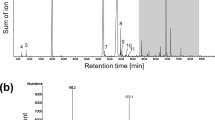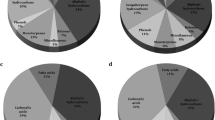Abstract
North American beaver (Castor canadensis) mark their territories with castoreum, the contents of their castor sacs. In their territories, beaver respond with scent marking to experimental scent marks consisting of castoreum, or selected single components. In part, the unique odor of castoreum is due to large amounts of phenolic compounds. Purified phenolic components were analyzed by GC, GC-MS, and NMR; identifications were confirmed by comparing the spectra of synthetic phenols with those of the isolated phenols. Of the 15 phenols reported elsewhere, only five were confirmed in our analysis; the other 10 phenolic compounds are either absent or are not volatile enough to be detected by our methods. In addition, 10 phenolic compounds have been identified in this study that were not reported in the previous papers concerning the constitution of castoreum.
Similar content being viewed by others
References
Allen, C.F.H., andGates, J.W., Jr. 1955.o-Eugenol.Org. Synth. Coll. 3:418–419.
Augustine, R.L. 1965. Catalytic Hydrogenation. Marcel Dekker, New York, p. 57.
Bollinger, K.S. 1980. Scent marking behavior of beaver (Castor canadensis). MS thesis. University of Massachusetts, Amherst, 186 pp.
Bollinger, K.S., Hodgdon, H.E., andKennelly, J.J. 1983. Factors affecting weight and volume of castor and anal glands of beaver (Castor canadensis).Acta Zool. Fenn. 174:115–116.
Brownlee, R.G., andSilverstein, R.M. 1968. A micro-preparative gas chromatography and a modified carbon skeleton determinator.Anal. Chem. 40:2077–2080.
Grønneberg, T.Ø. 1978. Analysis of a wax ester fraction from the anal gland secretion of beaver (Castor fiber) by chemical ionization mass spectrometry.Chem. Scr. 13:56–58.
Grønneberg, T.Ø., andLie, T. 1984. Lipids of the anal gland secretion of beaver (Castor fiber).Chem. Scr. 24:100–103.
Hodgdon, H.E. 1978. Social dynamics and behavior within an unexploited beaver (Castor canadensis) population. PhD thesis. University of Massachusetts, Amherst, 292 pp.
Hurd, C.D., andWinberg, H.E. 1942. The behavior of pyrogallol trimethyl ether and 3,4,5-trimethoxynitrile toward Grignard reagents.J. Am. Chem. Soc. 64:2085–2086.
Jackman, D.A., Sargent, M.V., andElix, J.A. 1975. Structure of the lichen depsidone pannarin.J. Chem. Soc. Perkin Trans. I 18:1971–1985.
Lederer, E. 1946. Chemistry and biochemistry of the scent glands of the beaver (Castor fiber).Nature 157:231–232.
Lederer, E. 1949. Chemistry and biochemistry of some mammalian secretions and excretions.J. Chem. Soc. (London) 1949:2115–2125.
Lederer, E. 1949. Castoreum and ambergris. Chemical and biochemical constituents.Perf. Essent. Oil Rec. 40:353–359.
Maurer, B., andOhloff, G. 1976. Zur Kenntnis der stickstoffhaltigen Inhaltsstoffe von Castoreum.Helv. Chim. Acta 59:1169–1185.
Müller-Schwarze, D., andHeckman, S. 1980. The social role of scent marking in beaver (Castor canadensis).J. Chem. Ecol. 6:81–95.
Müller-Schwarze, D., Morehouse, L., Corradi, R., Cheng-hua, Zhao, andSilverstein, R.M. 1986. Odor images: Responses of beaver to castoreum fractions, Vol. 4. pp. 561–570, in D. Duvall, D. Müller-Schwarze, and R.M. Silverstein (eds.). Chemical Signals in Vertebrates, Plenum, New York.
Svendsen, G.E. 1980. Patterns of scent-mounding in a population of beaver (Castor canadensis).J. Chem. Ecol. 6:133–148.
Valenta, Z., andKhaleque, A. 1959. The structure of castoramine.Tetrahedron Lett. 12:1–5.
Valenta, Z., Khaleque, A., andRashid, M.H. 1960. cis-Cyclohexane-1,2-diol in the beaver gland.Experientia 17:130.
Welsh, R.G., andMüller-Schwarze, D. 1989. Experimental habitat scenting inhibits colonization by beaver,Castor canadensis.J. Chem. Ecol. 3:887–893.
Author information
Authors and Affiliations
Rights and permissions
About this article
Cite this article
Tang, R., Webster, F.X. & Müller-Schwarze, D. Phenolic compounds from male castoreum of the North American beaver,Castor canadensis . J Chem Ecol 19, 1491–1500 (1993). https://doi.org/10.1007/BF00984892
Received:
Accepted:
Issue Date:
DOI: https://doi.org/10.1007/BF00984892




